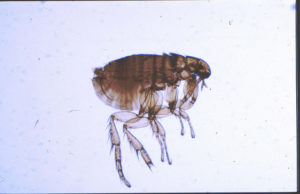
Hello! My grandfather has always been a fan of not the most standard solutions.
Moreover, this applied both to everyday life and to specific situations. I remember how he taught me to help pets get rid of fleas.
It is worth noting here that the beginning of the procedure itself was preceded by a kind of lecture lesson. I learned a lot of interesting details about parasites during this time. Want to tell you how much a flea lives without an animal? Even such a small nuance can play a role in the fight against them.
The content of the article:
- 1 How many fleas live in different conditions
- 2 Flea viability without animal or human
- 3 How long does a flea live?
- 4 Can fleas live on humans and how long do they live without animals
- 5 How many fleas live without food and in what way is it better to get rid of them?
- 6 How much can a flea live without a cat?
How many fleas live in different conditions
Fleas are blood-sucking insects and feed on fresh blood. It gives them vital energy, stimulates development, and promotes reproductive functions. To get the necessary portion of food, insects seek themselves as a host - a person or an animal.
Insects are able to exist autonomously for a long time in anticipation of favorable conditions.
Characteristic
A flea is a small insect (3-5 mm) belonging to the group of ectoparasites. The Latin name in translation means "wingless pump." The flea has a rounded body with a voluminous back. Moves by jumping with the help of long hind legs.
Small bristles covering the body of ectoparasite cling to animal hair and make it possible to find shelter in it. With its piercing-sucking mouth apparatus, the insect makes a puncture in the skin of the host and draws blood into the proboscis.
Moving from one host to another, a harmful insect quickly infects a large population of animals or people. In the Middle Ages, fleas provoked outbreaks of typhoid and plague.
On Earth, there are over 2 thousand species of these insects. In the wild, fleas live in bird nests, in earthen burrows, in tree hollows. They parasitize on different types of mammals, most often on cats, dogs, rats.
Fleas can exist in extreme climatic conditions: in hot tropics and cold arctic tundra. When the temperature drops, the insect falls into suspended animation, its life expectancy increases to 1 year.
Life cycle
The average life span of an adult flea is 3 months. During this time, the female lays about 500 eggs and makes up to 100 bites.
The duration of the transformation processes is due to the temperature and humidity of the environment:
- at high temperature - 7 days;
- at ordinary temperature - 30 days;
- at low temperatures - up to 10-12 months.
The larva gradually turns into a chrysalis. A week later, a new sexually mature individual leaves the cocoon. Air temperature directly affects the lifespan of a flea, its size. The hotter, the larger the individuals and the shorter their lifetime. Insects often die as a result of infections or from animal bites.
Favorable living conditions
A flea needs access to fresh blood for a normal existence. If the host mammal dies, the parasites immediately leave its corpse. However, the main habitat for fleas in dwellings is dark, dusty nooks.
Most often, the population lives behind skirting boards, in animal litter, under wooden floorboards, in boxes with children's toys, old things and clothes.
The most favorable conditions for the existence of ectoparasites provides a combination of high humidity and temperature. Ideal living background for different types of fleas:
- chicken - temperature from +20 to +25 ° C, humidity 80%;
- rats - temperature +15 ° C, humidity 60%;
- feline and canine - temperature +25 ° C, humidity 60%.
Life span
Fleas can do without food for a long time. The presence of host blood affects their ability to reproduce. In the absence of proper nutrition, the female does not have the ability to lay eggs.
The life cycle of a flea on the host and outside the animal has a different duration. In the cat’s hair, the insect goes through developmental stages in 50 days; without porridge - 1 year.
A dog flea develops on an animal in 25 days and can survive without it for 2 months. In humans, the life cycle of a parasitic insect can last from 2 weeks to 1 year.
The lifespan of certain types of ectoparasites:
- on rats - 2 months;
- on sheep - 12 months;
- on reindeer - 1.5 years.
The fleas that live on ungulate animals live the longest.
Methods of struggle
Insect resistance to adverse factors, the ability to fall into suspended animation make such methods of dealing with them, such as freezing or temporarily leaving the premises, ineffective.
Also, disinfection should be carried out regularly to prevent the reproduction of insects in the room. Preventive measures include:
- frequent wet cleaning;
- wiping the "dangerous areas" with decoctions of wormwood, mint, citrus, eucalyptus;
- processing of domestic animals and their beds;
- Laundry with hot ironing.
Flea viability without animal or human
Often people mistakenly believe that fleas live exclusively in animal hair, while without a host, on which they parasitize, they die in a very short time, because they are left without food.
But in fact, bloodsuckers do not live as long as they seem. An important role is played by environmental conditions and their favorableness to the parasite.
About what is the lifespan of fleas, where to find them, whether they can not die when they are without food for a long time, we will discuss below.
How many bloodsuckers live
The duration of flea imago is relatively small - 2-3 months. However, this period is enough for the insect to make 60-100 bites on the victim's body. During this time, sexually mature females need to lay about 400-500 eggs. Of course, the calculation assumes the existence of ideal conditions and the fact that the parasite dies of its own death.
Different types of fleas have adapted to a certain temperature, as well as air humidity, which are most preferable for them. Rat fleas live for almost 2 months at a temperature of 14-15 ° C and humidity reaching 60%.
But chicken fleas need high temperature and humidity - 40C and 80%. In residential premises, parasites can exist for about the same time if they are not poisoned by insecticides, and bloodsuckers regularly feed on the blood of the victim.
If the temperature rises above a certain point, then fleas die faster. So, the lifespan for cat and dog fleas is significantly reduced at temperatures reaching 36-37 ° C. Parasites live only 3-4 weeks. However, the offspring grows faster, which reduces the duration of the breeding cycle.
But low temperatures turn out to be much preferable for fleas, since then insects live much longer, individual individuals are able to die only at one and a half to two years of age.
Also, depending on the temperature, the duration of the breeding cycle also changes. Flea offspring under favorable conditions develops within a month. If you increase the temperature, then this period will be reduced to a week, and if it decreases, it can increase up to 8 months.
Usually, parasite eggs develop over 14 days, another 3 weeks of the flea remains in the cocoon of the pupa.
Thus, the full cycle (in other words, from “egg to egg”) is from 10 days to a year. The life span of an individual varies and depends on the temperature; it can take from 1.5 months to 2 years.
Being a chrysalis, fleas are able to endure any harsh conditions without prejudice to themselves. At this stage, the insect will not die in cold weather, extreme heat and even exposure to insecticidal chemicals. It is believed that the chrysalis can remain viable for several years.
If the animal on which the flea was parasitized dies, then the insect immediately leaves the corpse, because the food source disappears (they cannot feed on the blood of a dead creature).
Are there long-lived fleas? The reaction of the animal to flea bites
Observations show that individuals that parasitize ungulates are distinguished by the longest life span.
Some individuals found in northern animals, because of adaptability to low temperatures and the ability to fall into a stupor, live 14-16 months or longer. In cold conditions, they die not so fast, they die, reaching 1-2 years.
How many fleas live on humans, cats, dogs?
Someone will be surprised at this statement: fleas on the human body do not constantly live.They do not live round the clock in the hair of domestic or wild animals, although they can often be seen precisely between the hairs.
It is worth noting that these bloodsucking, in principle, are not able to live long time on the body of a warm-blooded creature, since there are no conditions for their reproduction.
A person, cat or dog for a flea is just a food source, so they jump onto the body just to get enough blood. An insect can bite its victim once or several times, and the nutrition process takes from a minute to 2-3 hours, then the parasite leaves the temporary host.
Some owners of furry four-legged or livestock think that fleas live in the hair of mammals, but this impression is created because the number of bloodsuckers is too large, so it seems that they are always on the body.
Thus, when fighting fleas, it is necessary to destroy not only individuals that are in the field of visibility, but also treat the surrounding area with insecticides.
Usually, parasites find a place to live permanently in the animal litter, in carpets and rugs, under baseboards and crevices, among dusty old things, near debris.
As a rule, fleas do not climb into layers of clothing, rarely appear in cabinets and chests of drawers. Usually parasites are located in the immediate vicinity of the food source.
Can fleas live without food?
Lack of food is not a problem - individuals can starve for a sufficiently long period.
Feline and human fleas can survive without food for several months. During this period, they continue to move, the state of suspended animation does not occur.
If you want to get rid of fleas by starving them and going for a long time to visit or moving to another apartment, then you will not succeed. Individuals can do without food without problems, and when you return, they will continue to bite their victims.
It is even more naive to believe that fleas will disappear from a private home until the owners are here. Bloodsuckers are able to attack rodents, thereby continuing to multiply.
What factors affect the life span of the parasite
As already mentioned, temperature changes play a large role. In addition to it, flea life expectancy is affected by:
- humidity - low (but not too) humidity is considered favorable for fleas;
- food source - parasites that do not receive fresh blood for a long time live longer;
- invariability by the environmental parameter - insects living in places with constant jumps in humidity and temperature form the ability to fall into a stupor, as a result of which the life expectancy becomes longer.
When propagating for fleas, the number of offspring from a single flea is important, not the rate of development of the larvae. As a rule, the reproduction process of their own kind is continuous, therefore, in the fight against bloodsucking, a person must destroy not only the parasites visible on the animal’s hair, but also the larvae hiding in secluded places.
How long does a flea live?
Quick answer: 2-3 months, depending on the type of flea.
A flea is a detachment of blood-sucking insects with a complete transformation. It has a mouthpart, which allows you to pierce the skin of the owner and suck out blood.
The average lifespan of one flea rarely exceeds 2-3 months. But even this period is enough for the insect to make up to hundreds of bites and lay about 500 eggs! Yes, yes, and all this at such a tiny size, when a flea can often be seen only under a magnifying glass.
Of course, everything depends directly on the type of flea itself, as well as on the conditions of its existence. So, the conditions for different types of fleas can be very different. If the chicken flea lives at a temperature of 40 ° C, then the rat flea lives at 15 ° C. Agree, the difference is extremely large.
Fleas living in apartments or houses live about the same. This is if you do not fight them.
Generally speaking, fleas are very sensitive to the temperature regime. This usually happens: the higher the ambient temperature, the higher the likelihood of an insect's death. But with a decrease in temperature, the flea's lifespan can greatly increase.
Large species of fleas, whose size reaches several millimeters, live the longest. Such species are able to live 1.5-2 years.
Interestingly, fleas cannot live on animals and humans for a long time. Why? For breeding, they prefer quiet and secluded places to which the body of an animal or person is unlikely to attribute. Here they are only trying to get drunk with blood, no more.
What is even more surprising is that fleas are able to live even without food for up to several months, while maintaining their mobility. In this case, the female will not be able to lay eggs - for this she needs blood.
Can fleas live on humans and how long do they live without animals
Many recklessly believe that fleas live only on animals, for example, cats and dogs, and without them they quickly die without a food source.
In reality, there are no long-livers among fleas, and these insects live very briefly, and environmental conditions have a very significant effect on the life of the parasite.
About the life span of fleas in different conditions, about exactly where adult parasites and their larvae live in the apartment, and also how long they can live without food - we will talk about this in more detail later.
The life span of a parasite
The average lifespan of an adult flea is 2-3 months. During this time, the insect usually manages to make about 60-100 bites on its prey, and the female lays from 400 to 500 eggs.
For example, rat fleas live for about 2 months at a temperature of 14-15 ° C and a humidity of about 60%, and chicken fleas live the same period at 40 ° C and a relative humidity of about 80%.
About as many fleas live in an apartment, provided that they are not struggling with special drugs here and insects have constant access to food.
With an increase in the average temperature in the habitat, the period of life of fleas decreases. At extreme temperatures for each species (for ordinary cat and dog fleas in apartments it is 36-37 ° C), insects live only about three to four weeks.
On the contrary, at low temperatures, the flea's life span is extended, and parasites can survive up to one and a half to two years at the lower boundary of their species temperature range.
At high temperatures, fleas grow larger than the average representative of the species. On the contrary, with decreasing temperature they become smaller.
The flea breeding cycle is also temperature dependent. Their larvae at optimal temperatures develop about a month, at high - a little more than a week, and at extremely low - up to 8 months.
About two weeks later eggs develop, about three weeks the insect is at the stage of the pupa.
In general, from egg to egg, the flea breeding cycle takes from 10 days to 1 year. And the lifespan of one flea from an egg to death can stretch from a month and a half to several years.
As a rule, fleas in nature do not live long even in comfortable conditions - they are constantly destroyed by the owners themselves, biting them from the wool. In addition, fleas die from their own infections and parasites.
At the pupal stage, fleas can survive very harsh conditions - frost, icing, severe droughts and the effects of insecticides. Theoretically, pupa fleas are able to remain viable for several years.
So, for example, if the animal on which fleas were fed dies, insects almost immediately leave its corpse (fleas cannot feed on blood on a fallen animal).
Long-lived fleas, or when parasites break records
In general, of all fleas, large species live longer than all, parasitizing mainly on ungulates.
For about a year, the so-called "motley worm" lives on the sheep - the Tien Shan flea, reaching a length of 7 mm. Some fleas parasitizing on northern animals can fall into a prolonged stupor in the winter season and live on the whole for more than 14-16 months.
But about the lifespan of fleas on humans and animals, it should be said separately - due to established stereotypes, many incorrectly believe that parasites live on their hosts constantly.
Debunking Myths
Scientists are well aware that fleas do not live on humans. They also do not live permanently on other mammals, including domestic animals (although it seems to many that the main habitat of the parasites is the hair of cats and dogs).
Fleas in general cannot live permanently on their owners - they need to breed in calm and safe places, and the human and animal bodies are not suitable for this.
However, due to the large number of parasites, the impression is usually made that there are a lot of them on the animal and they, in fact, live here.
So, given that fleas do not live on animals and humans, they should be sought elsewhere in the apartment. Usually they hide in the litter on which the animal rests, in carpets and behind them, behind skirting boards, in crevices of floors, piles of garbage in the corners, among the old rubbish. Here their worm-shaped larvae usually develop.
Fleas rarely live in clothes, although if they are wound up in an apartment, then they can be found in the closet. The main requirement for the place in which they are located is a short and quick access to food (animal or human).
Although fleas live without food, they live long enough.
Parasites without a host: how long can fleas live without food?
Like many other blood-sucking insects, fleas can starve for a long time. Feline and human fleas, most often attacking humans, can go without food for several months, while maintaining mobility and not falling into suspended animation.
However, no matter how long a flea lives without food, parasites cannot reproduce without constant reinforcement. Female fleas for laying eggs need to drink blood.
Thus, although fleas are able to survive long enough without an animal or human, they cannot reproduce.
In practice, this means that if people and animals leave the apartment for several weeks or even months, fleas will calmly wait for them and bite immediately after their return. Do not expect that while the apartment owners are resting on vacation, the parasites will die of starvation.
And the fleas that live in dachas and in private houses calmly parasitize on rats and mice living here, and therefore, even in the absence of humans, they do not starve for most of the year.
What determines the lifespan of fleas?
In addition to low temperatures, other factors can affect the lifespan of fleas:
- Humidity - at low but tolerable humidity, fleas live a little longer, although the influence of this factor is not as significant as the effect of temperature.
- The presence of food. Fleas can starve for a very long time, while their life expectancy during a hunger strike also increases.
- The constancy of the physical parameters of the environment. In the case of regular temperature jumps, parasites can periodically fall into a stupor, and in general, their lifespan increases.
It is always worth remembering that fleas are typical parasites, the success of reproduction of which is determined not so much by speed and timing, but by the number of descendants of each individual flea.
Therefore, when hatching fleas, their total persecution should be carried out, destroying both adult insects and larvae. Only in this case can parasites be eliminated quickly and completely.
How many fleas live without food and in what way is it better to get rid of them?
Fleas feed exclusively on the blood of living creatures and are not even averse to feasting on humans. On the body of the insect numerous bristles are located, thanks to which it can cling to animal hair or to human clothing, on which there are small villi.
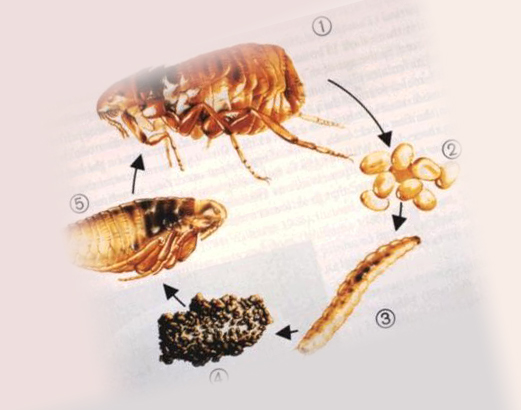
Parasites have legs that allow them to jump over very long distances, so it is not recommended to pet stray animals on the street. During contact with street pets, fleas can jump onto you.
The insect has a fairly small size and has a brown body color. It is very difficult to kill a flea mechanically, since the parasites perfectly sense the danger. If insects know that they are threatened with death, then they immediately move to a safer place.
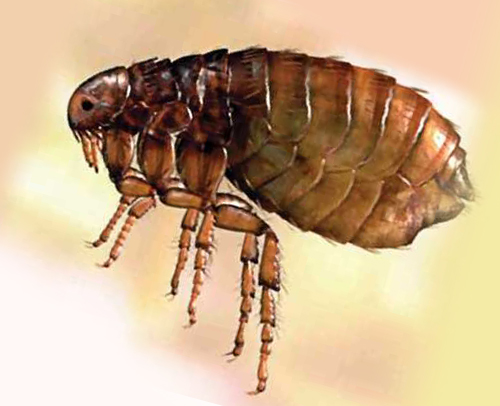
How do fleas breed and where are they most common?
Fleas go hunting when winter passes, and spring only begins to come, which is why at this time it is time for the pets to wear an anti-flea collar.
The flea breeding cycle takes about 4 weeks and consists of several stages, which always take place at regular intervals.
Use a vacuum cleaner to get rid of flea eggs. You cannot remove all the eggs, so when buying a product, pay attention to ensure that it has a lasting effect in order to destroy a new generation.
First, the insect lays an egg, after which a larva appears, from which an adult grows later. Larvae feed on waste that remains after adult fleas.
Fleas live not only on animal hair, but also in your entire apartment.To detect insects, carefully inspect the floor of your room, especially if there is a carpet on it, and do not forget to check the bottom of the wall.
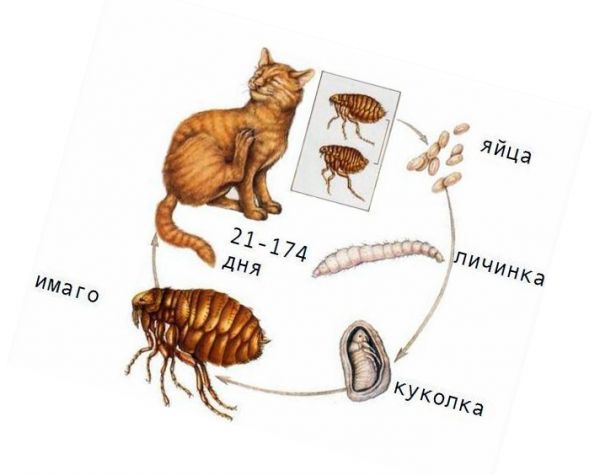
How to understand that your pet has got parasites?
In the early stages of insects, it’s quite difficult to notice, but after a long time, you will notice obvious signs of the presence of fleas in your home.
You will be able to immediately notice the insects if your cat begins to be allergic to their bites, then all the signs of the disease will begin to appear immediately, and every day your pet will become worse if you do not start to remove fleas from your pet's fur.
If you notice that every day your pet is getting worse and worse, then most likely these are signs of an allergic reaction. Do not self-medicate and consult your veterinarian so that he can stop her on time.
Unlike bedbugs, fleas do not inject painkillers into the body during a bite, so if your animal is very often suffering from insomnia, then this is a sure sign that fleas are wound up in your apartment.
In the later stages of insect infestation, the pet begins to strongly comb the wounds that remain after flea bites. Soon ulcers begin to appear on the body of the animal, and there is a risk of introducing a dangerous infection into the bloodstream.
In the places of the main accumulation of fleas in a dog or cat, hair may start to fall out. To understand that your pet has got fleas, put it on a white sheet of paper and comb it thoroughly.
If black dots appear on the paper, then this is nothing but a flea feces, and you should no longer have any doubts about the presence of insects in the house.
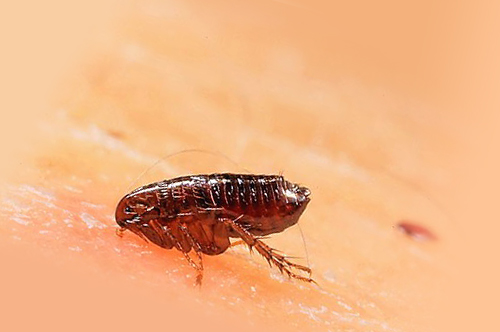
Very often fleas like to settle in places that are not accessible to your ordinary gaze. Therefore, start inspecting your pet from the area near the tail and near the abdomen. Swipe the coat with your hand, slightly pushing it to notice insects parasitizing on the skin of the animal.
How many fleas live?
Fleas spend quite a long life, unlike other insects. It is with longevity that their adaptation to even the most dangerous conditions is associated.
Perhaps the only thing that insects do not tolerate is water, which can be used to detect them. When bathing an animal, pay attention to its eyes, which almost never get wet. Upon contact with water, fleas will always crawl to a drier place.
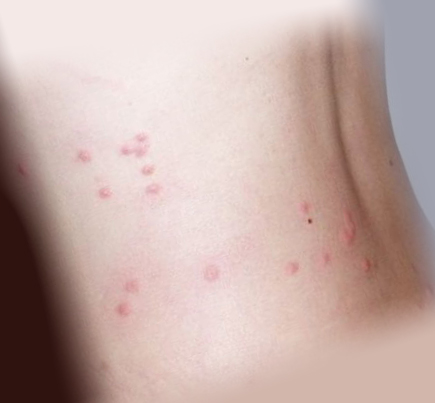
Answering the question how many fleas live without food, we can say that for a very long time. Therefore, do not think that if you brushed off an insect from a pet, it will die immediately. Most likely, the parasite will simply find a new victim.
You may well be this victim, as insects are able to adapt even to human blood, but this should take extra time.
With fleas, everything turned out to be more complicated, Dichlorvos more or less helped us, after its application we immediately noticed very good results. Maria, Moscow
Feedback: I love animals very much and therefore on the street I can’t get past stray cats and dogs. I always try to feed them and give them attention, but I never would have thought that this would play a trick on me.
It is good that I immediately noticed fleas on my clothes, and they did not have time to move to my house, so be careful. Karina, Saratov
http://opklop.ru/blohi/pro-bloh/skolko-zhivut-blohi-bez-pitaniya-164/
How much can a flea live without a cat?
Sometimes it seems that these parasites are simply immortal! No matter how many you bring them out, they still continue to multiply. This assumption has a real basis. Fleas are actually very hardy. Parasites can sometimes survive even a cat in whose hair they live.
Moreover, the opinion that comfortable conditions prolong the life of the parasite is wrong. About a flea, you can say this: the worse it is, the better. In the heat, in the presence of a constant power source, all processes of the parasite are accelerated.
Under normal environmental conditions, the flea has a lifespan of about three months. However, this applies only to those insects that die by their death. Many, getting on the tooth or claw of a cat, die much earlier.
Can an insect live without a host?
Most people believe that a flea can live only on the skin of an animal. This is a misconception. The parasite does not live on a cat or dog at all.
The flea periodically jumps on the wool to get to the power source. The meal takes parasites from several minutes to a couple of hours. Then, pumping blood, fleas leave their prey.
Where do parasites live? They live in dark, dusty places in an apartment or house, where a person’s hand with a vacuum cleaner rarely appears.
This is the mat on which the cat sleeps, the far corner under the sofa, the carpet rolled up in the closet, etc. There, fleas multiply, laying eggs in which larvae mature.
How many fleas live without animals and can they live on humans
Many recklessly believe that fleas live only on animals, for example, cats and dogs, and without them they quickly die without a food source.
In reality, there are no long-livers among fleas, and these insects live very briefly, and environmental conditions have a very significant effect on the life of the parasite.
About the life span of fleas in different conditions, about exactly where adult parasites and their larvae live in the apartment, and also how long they can live without food - we will talk about this in more detail later.
Life time
The average lifespan of an adult flea is 2-3 months. During this time, the insect usually manages to make about 60-100 bites on its prey, and the female lays from 400 to 500 eggs.
All these figures are characteristic of the ideal conditions for the existence of the parasite, while it is understood that the flea dies by its natural death.
About as many fleas live in an apartment, provided that they are not struggling with special drugs here and insects have constant access to food.
Parasite characterization
Flea - a parasitic wingless blood-sucking insect, beautifully called the Latin "Siphonaptera". The average static insect of this species in size is from one to five millimeters.
The color of adults is brown, young are often black, but there are also individual subspecies, the color of which varies from straw to black-brown.
In addition, there are three pairs of legs in the fleas, the back of which plays a major role during jumping. A similar construction of the limbs of this insect allows it to freely cling and move through the body of the host under any inclination.
Life Span of Fleas in Nature
In the conditions most suitable for an insect, its life lasts about 3 months. During this time, one female lays 400-600 eggs, and each insect can make about a hundred bites. Only by fulfilling this “minimum plan” does the bloodsucker die naturally.
Suitable conditions are matching certain humidity and air temperature. So, rat fleas prefer cool humidity: about 14 degrees heat and more than 55% humidity. Insects who live in apartments feel good in such conditions. Flea life will lose its meaning without quick access to food.
If the insect is in conditions of elevated temperatures, all phases of its development are much faster. An adult insect becomes much larger.
Under ordinary conditions, the formation of larvae takes about 30 days, while in the heat - 7. Egg development ends after 14 days, another half a month the insect exists in the pupal phase.
In nature, flea lifespan does not differ in duration under any conditions, since the carriers themselves kill them by biting them from the wool. No less parasites die from infections. There are also individuals who in their life have time to change several owners, some of which die.
A fallen animal is immediately abandoned by insects.
Where do the bloodsuckers come from
Getting into a favorable environment, which are cracks in the walls and floor, animal litter, fleecy surfaces of furniture and carpets, in a couple of weeks the larvae develop into an adult insect.
Since fleas are the most common in the family of feline ectoparasites, it is very difficult to insure themselves against their appearance.
The ways of infection are diverse - it can be infection from another infected animal (even with short-term contact), a cat flea can wait for your pet during a walk, infection can occur through a flea droppings, and you can bring cat fleas to your clothes or shoes to your beloved cat.
Up to 200 parasites can live on one cat. A female flea lays up to 400 eggs daily and more than 2000 for its life. A female cat flea at a time is able to lay up to 4-8 oval-shaped eggs that fall down and do not stick to the cat's hair.
Tracking the path of infection is very difficult, and often - there is no need. But timely diagnosis of cat infection with fleas is very important.
leave a comment